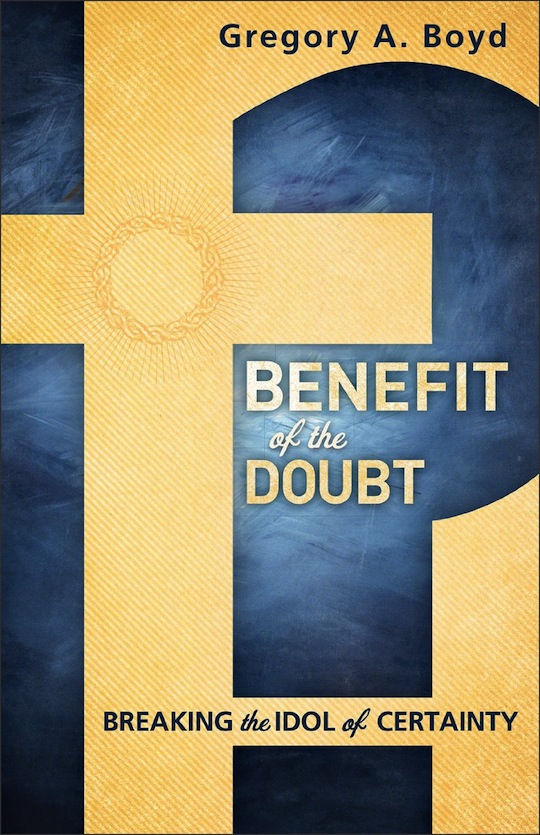We run our website the way we wished the whole internet worked: we provide high quality original content with no ads. We are funded solely by your direct support. Please consider supporting this project.

Rachel Held Evans Interviews Greg on Benefit of the Doubt
We shared an interview that Frank Viola did with Greg yesterday, and we’re thrilled to share an interview that Rachel Held Evans posted today. Rachel is very familiar with the resistance and criticism that comes when dearly held beliefs are challenged. We feel like she is a kindred spirit in this regard. We hope you’ll take the time to read the whole interview and leave her a comment of encouragement. There’s a kingdom revolution taking place and she’s in the thick of it.
Many people are unaware that Greg dives into the topic of Old Testament violence in Benefit of the Doubt. In this particular question from Rachel, you can see a sneak peek of where he’s headed with Crucifixion of the Warrior God. If you’re one of the people waiting anxiously for that book to come out, you’ll be happy to read this chapter.
From the interview:
You acknowledge that one of the greatest challenges confronting people who believe the Bible is “God’s Word” concerns the violent portraits of God in the Bible. and you spend a whole chapter on this topic. What advice do you have for people who are deeply troubled by these portraits?
There are three things I share inBenefit of the Doubt about this incredibly important topic. The first is that I attempt to show that the revelation of God in Jesus Christ isn’t just one revelation among many others in Scripture. He is rather depicted as the supreme revelation that culminates and surpasses all others. God spoke in many different ways in the past, the author of Hebrews tells us, but in these “last days” he has spoken “through the Son.” And in contrast to all that came before, the Son is “the radiance of his glory” and “the exact representation of his being (hupostasis, meaning “essence,” Heb. 1:1-3). This is why Jesus could say such radical things as; “If you see me, you see the Father” (Jn.14:9) and could claim that all Scripture points to him (Jn 5:39-45; Lk 24: 25-7; 44-7). What this implies, I contend, is that, whether we can explain the violent portraits of God in the OT or not, it would be unfaithful for us to ever allow anything we find in the OT to compromise what we learn about God in him.
Second, I argue that as the NT depicts it, the cross sums up and supremely expresses everything Jesus was about. This is why John said, on the basis of what he learned about God from Jesus, that “God is love” (I Jn,.4:8) and then defined the kind of “love” that God is by pointing us to the cross (I Jn 3:16). God’s very essence, in other words, is cross-like love. On the one hand, this increases the problem of the OT’s violent portraits of God, for the cross reveals a God who would rather did for his enemies than use his power to crush them. So we have to wonder, how do portraits of God commanding genocide or causing mothers to cannibalize their babies point to the enemy-loving, non-violent God revealed on the cross?! On the other hand, however, I argue that the cross itself holds the key to solving this problem, which leads to my third point.
The cross reveals that, out of his covenantal faithfulness and unfathomable love, God is willing to stoop to bear the sin of his people and thereby take on an appearance that reflects the ugliness of their sin. Yet, in doing this, God reveals his true nature, for as we look upon the God-forsaken, guilty-appearing criminal on the cross, we know that it was God who voluntarily stooped an infinite distance to become this for us. Now, if the cross reveals what God is really like, then it reveals what God has always been like. And this means we should read Scripture with the awareness that God has always been willing to stoop to bear the sin of his people and take on appearances that reflect the ugliness of their sin.
I thus suggest that we should read all Scripture “through the lens of the cross,” and when we do this, we can begin to see how even the most horrendous portraits of God in the OT bear witness to the God revealed on the cross. The cross reveals God to us only when we look past the surface appearance that reflects the ugliness of our sin and discern in its depth our gracious God stooping to bear our sin and take on this ugly appearance for us. In this light, I suggest we should read Scripture always asking, where else might we find that God is revealed not by how he appears on the surface, but by what faith can discern as we look past the surface to discern God humbly stooping to bear the sin of his people?
My short answer to this question is that, whenever we come upon portraits of God that, to one degree or another, fall beneath the beautiful, non-violent portrait we are given in the crucified Christ, we should assume that the revelatory content of these portraits is, to this degree, not found on the surface of the portrait itself, but in what faith can discern happening beneath the surface as it beholds God stooping to bear the sin if his people. Hence, I submit that the ugliness of portraits such as the one of Yahweh commanding his people to slaughter “everything that breathes” or of causing mothers to cannibalize their children reflects the ugly, fallen, culturally conditioned hearts of his people, not God himself. What rather reveals God is that, out of his covenantal faithfulness and unfathomable love, he was willing to stoop to bear the sin of his people by being willing to take on this literary appearance in the inspired record of his covenantal activity (viz. the biblical narrative).
Category: General
Tags: Benefit of the Doubt, Cruciform Theology, Doubt, Faith, Non-Violence, Rachel Held Evans
Related Reading

The Heavenly Missionary
In his second sermon introducing the ideas in Crucifixion of the Warrior God, Greg suggests a metaphor to help us frame the things we encounter in the Old Testament that seem at odds with the God we find in the life and death of Jesus. God is a heavenly missionary who stoops to accommodate our…

The God Who Embraces Our Doubt
Lawrence OP via Compfight Zack Hunt over at The American Jesus posted some of his thoughts on doubt, and it seemed fitting on this week before the Doubt, Faith & the Idol of Certainty conference to share what he had to say. We’re thinking he must have stumbled on Greg’s book or maybe God is…

A Response to “Are Greg Boyd and I Reading the Same Old Testament?”
Collin Cornell has recently published a review of Cross Vision (CV) and, less directly, of Crucifixion of the Warrior God (CWG) in The Christian Century. In this post I will respond to the two major objections Cornell raises against these books. Cornell begins by recounting a discussion I had with a woman who was deeply impacted…

Isn’t the Resurrection the Ultimate Revelation of God? (podcast)
Greg considers the relationship between Christ’s death and resurrection. http://traffic.libsyn.com/askgregboyd/Episode_0744.mp3

Podcast: A Cross Vision Reading of David & Goliath
Dan takes a shot at interpreting the David & Goliath story through a cruciform lens. http://traffic.libsyn.com/askgregboyd/Episode_0294.mp3

Redefining Transcendence
God is transcendent, which basically means that God is “other” than creation. The problem is that classical thinking about God’s “otherness” has been limited to what reason can discern about God. As a result, all that can be said about his transcendence is what God is not. We are thus unable to acquire a positive…
